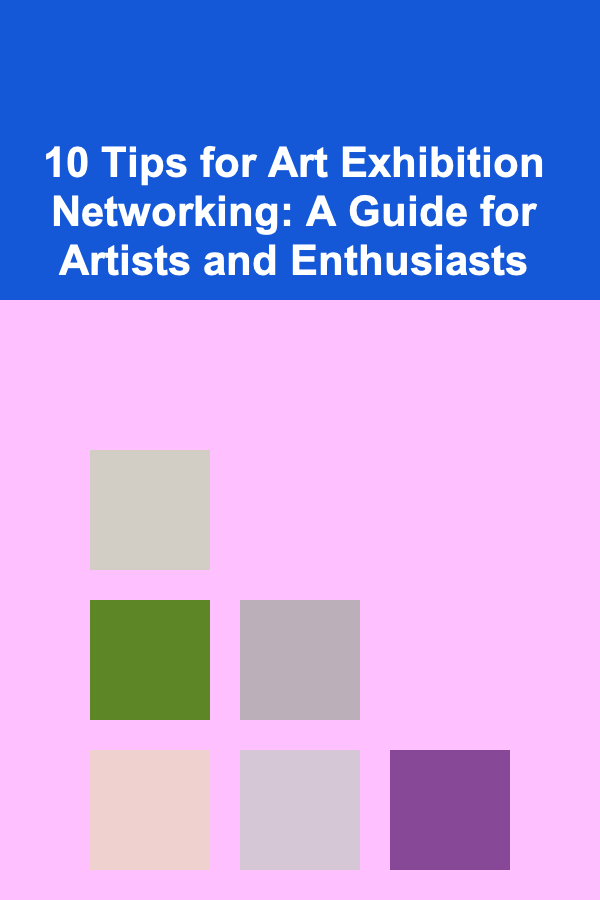
10 Tips for Art Exhibition Networking: A Guide for Artists and Enthusiasts
ebook include PDF & Audio bundle (Micro Guide)
$12.99$7.99
Limited Time Offer! Order within the next:

Networking at art exhibitions is an essential yet sometimes daunting activity for both emerging and established artists, as well as art enthusiasts. Beyond admiring the artwork on display, exhibitions offer a unique opportunity to build relationships, gain exposure, and open doors to future collaborations or career advancements. However, successful networking requires more than just showing up and handing out business cards. It involves strategy, confidence, genuine engagement, and understanding the social dynamics of the art world.
This comprehensive guide will delve deeply into 10 essential tips for art exhibition networking. Whether you're an artist seeking gallery representation, a collector hunting for your next acquisition, or an enthusiast hoping to immerse yourself more deeply into the art community, these strategies will empower you to connect meaningfully and purposefully.
Prepare Ahead of Time: Know the Exhibition and Its Key Players
Preparation is the cornerstone of effective networking. Before attending an art exhibition, research the event thoroughly:
- Understand the Theme and Artists: Read about the exhibition's theme, participating artists, and the types of works showcased. This knowledge helps you engage in informed conversations and demonstrate genuine interest.
- Identify Key People: Look for curators, gallery owners, critics, and influential artists who will be attending. Platforms like the exhibition's website, social media pages, and art publications can provide this insight.
- Set Clear Objectives: Define what you want to achieve --- whether it's meeting a particular gallery director, finding collaborators, or simply expanding your network.
- Prepare Your Elevator Pitch: For artists, craft a concise and compelling description of your work and artistic philosophy. For enthusiasts, be ready to explain your interest and involvement in the art scene.
By arriving well-prepared, you'll feel more confident and poised, making your interactions more impactful.
Dress Appropriately and Mind Your Body Language
First impressions matter deeply in social and professional settings. Dressing appropriately for the occasion shows respect and professionalism:
- Dress Smart-Casual or Artistic: Choose attire that reflects the creative atmosphere but remains polished. Avoid overly casual or too formal clothing unless the event calls for it.
- Body Language Speaks Volumes: Smile, maintain good eye contact, and adopt an open posture. Avoid crossing your arms or looking distracted, as these can signal disinterest.
- Approachability: Be mindful of your facial expressions and gestures to invite conversations rather than deter them.
Non-verbal cues are as important as what you say, so embody confidence and openness.
Start Conversations Naturally: Focus on the Art
At exhibitions, the artwork itself is the easiest and most effective conversation starter:
- Ask Open-Ended Questions: "What drew you to this piece?" or "How do you interpret this work?" These encourage discussion rather than yes/no answers.
- Share Your Perspective: Offer your insights or emotional reactions to a piece. Authenticity resonates more than rehearsed lines.
- Use Artwork as a Bridge: If you know the artist or curator, you can smoothly transition to introducing yourself and explaining your interest.
- Listen Actively: Show genuine curiosity and avoid dominating the conversation. People appreciate being heard.
Natural conversations foster trust and can lead to deeper connections.
Carry Essential Materials but Don't Overwhelm
Being prepared means having the right tools to facilitate follow-ups, but avoid overwhelming others:
- Business Cards: Carry high-quality, visually appealing cards that include your name, title (artist, collector, enthusiast), contact details, and website or portfolio link.
- Portfolio or Lookbook: For artists, have a digital portfolio accessible via your phone or tablet, ready to showcase your work without being intrusive.
- Note-Taking: Use a small notebook or digital app to jot down names, details, and follow-up points immediately after conversations.
Avoid handing out materials indiscriminately; offer them when the conversation naturally leads to exchanging contacts.
Engage with Curators and Gallery Owners Respectfully
Curators and gallery owners hold considerable influence in the art world, so building a respectful and professional rapport with them is vital:
- Express Interest in Their Work: Ask about their curatorial vision or gallery representation criteria.
- Be Concise and Relevant: Respect their time by clearly explaining how your work or interests align with their focus.
- Avoid Pressuring: Don't aggressively pitch or demand representation. Instead, plant seeds for future conversations.
- Follow-Up Politely: If you exchange contacts, send a thoughtful message referencing your discussion, and possibly share links to your portfolio.
Building these relationships takes patience and authenticity over time.
Network Beyond the Exhibition Floor
Many networking opportunities exist outside the official exhibition space:
- Attend Related Events: Openings, artist talks, panel discussions, and after-parties offer less formal settings conducive to relationship building.
- Participate in Workshops or Community Programs: These settings encourage interaction and collaboration among artists and enthusiasts.
- Join Art Organizations or Clubs: Being active in local art communities can extend your network well beyond single events.
Networking is a continuous process that flourishes in varied environments.
Leverage Social Media Strategically
In the digital age, social media plays a crucial role in art networking:
- Follow and Engage: Before the event, follow artists, galleries, and curators involved in the exhibition. Like, comment, and share their posts thoughtfully.
- Live Post During the Event: Share images, videos, or stories to showcase your presence and enthusiasm, tagging relevant accounts.
- Connect Online After Meeting: Send personalized messages referencing your meeting to solidify connections.
- Build a Consistent Online Presence: Regularly post your work, thoughts on art, and event participation to establish credibility.
Strategic social media use can complement in-person networking and broaden your reach globally.
Cultivate Genuine Relationships Over Transactional Contacts
Networking isn't about collecting as many business cards as possible; it's about creating meaningful connections:
- Show Empathy and Interest: Remember personal details and inquire about others' projects or challenges.
- Offer Help and Value: Share information, opportunities, or introductions without expecting immediate returns.
- Be Patient: Relationships develop over time. Regularly check in or share relevant updates to maintain bonds.
- Avoid Overbearing Behavior: Respect boundaries and avoid pushing conversations or favors too hard.
Quality relationships lead to lasting collaborations and mutual support in the art world.
Manage Rejection and Social Anxiety Gracefully
Not every attempt to network will be successful, and some interactions may be intimidating:
- Stay Positive: Rejection is a normal part of networking. Use it as feedback, not a reflection of your worth.
- Practice Social Skills: The more you engage, the easier it becomes. Consider role-playing or attending smaller events to build confidence.
- Focus on Listening: Sometimes stepping back and listening can be less stressful and equally valuable.
- Take Breaks if Needed: Exhibitions can be overwhelming. Step outside or find quieter spaces to recharge.
Maintaining emotional resilience ensures you continue networking productively.
Follow Up and Nurture Your Network
The work doesn't end when the exhibition closes:
- Send Thank-You Messages: A brief note expressing appreciation for their time reinforces a positive impression.
- Share Relevant Updates: If you exhibit work, participate in other events, or publish articles, share these with your contacts.
- Schedule Meetings or Calls: Where appropriate, propose coffee chats or virtual meetings to deepen connections.
- Maintain a Network Database: Keep organized records of your contacts, their roles, and interaction history.
Consistent follow-up turns initial meetings into lasting relationships.
Conclusion
Networking at art exhibitions is an invaluable tool for artists and enthusiasts to foster growth, collaboration, and opportunity within the art world. By preparing thoroughly, engaging genuinely, respecting social dynamics, and leveraging both in-person and digital platforms, you can build a robust network that supports your artistic and cultural aspirations.
Remember, successful networking is less about the quantity of contacts and more about the quality of relationships. With patience, authenticity, and strategic effort, art exhibitions can become fertile ground for meaningful connections that enrich your creative journey.
Whether you're stepping into your first exhibition or are a seasoned participant, these 10 tips provide a roadmap to navigate the vibrant, sometimes challenging, but always rewarding world of art exhibition networking.
Reading More From Our Other Websites
- [Home Cleaning 101] How to Tackle a Post-Party Cleaning Session
- [Reading Habit Tip 101] Must-Read Books for Every Season of the Year
- [Scrapbooking Tip 101] How to Blend Watercolor Washes with Collage for Dreamy Scrapbook Backgrounds
- [Reading Habit Tip 101] The SQ#R Method: A Step‑by‑Step Guide to Mastering Study Texts
- [Home Soundproofing 101] How to Use Furniture to Absorb Sound and Improve Room Acoustics
- [Beachcombing Tip 101] From Shoreline to Kitchen: Identifying Safe and Edible Sea Beans
- [Metal Stamping Tip 101] Bridging the Gap: Best Practices for Merging CAD Data with CAM Machining in Metal Stamping Operations
- [Small Business 101] Best Small Business Social Media Strategies for Local Businesses
- [Organization Tip 101] How to Keep Your Travel Insurance Information Organized
- [Home Space Saving 101] How to Create a Space-Saving Home Office Without Sacrificing Comfort

How to Sell Digital Products Successfully for Health Coaches
Read More
How to Use Mirrors to Enhance Small Spaces
Read More
How to Identify Nebulae
Read More
How to Cook Japanese Home Cooking Favorites
Read More
10 Tips for Incorporating Doodling into Your Journaling
Read More
10 Essential Tools for Quilling Success
Read MoreOther Products

How to Sell Digital Products Successfully for Health Coaches
Read More
How to Use Mirrors to Enhance Small Spaces
Read More
How to Identify Nebulae
Read More
How to Cook Japanese Home Cooking Favorites
Read More
10 Tips for Incorporating Doodling into Your Journaling
Read More